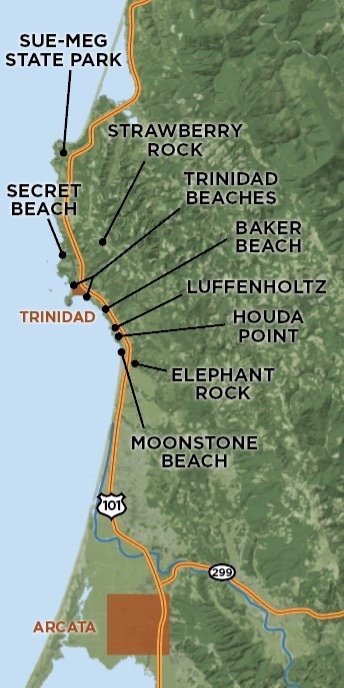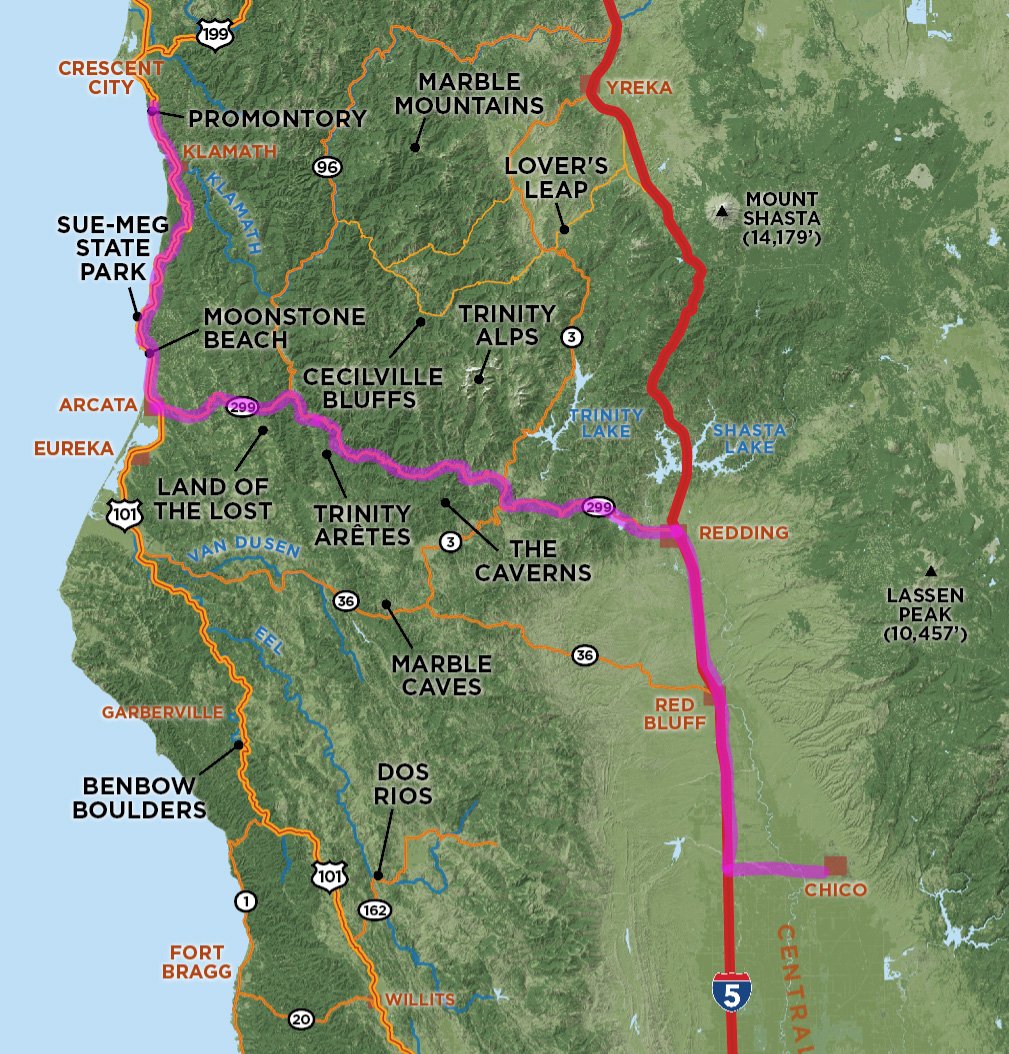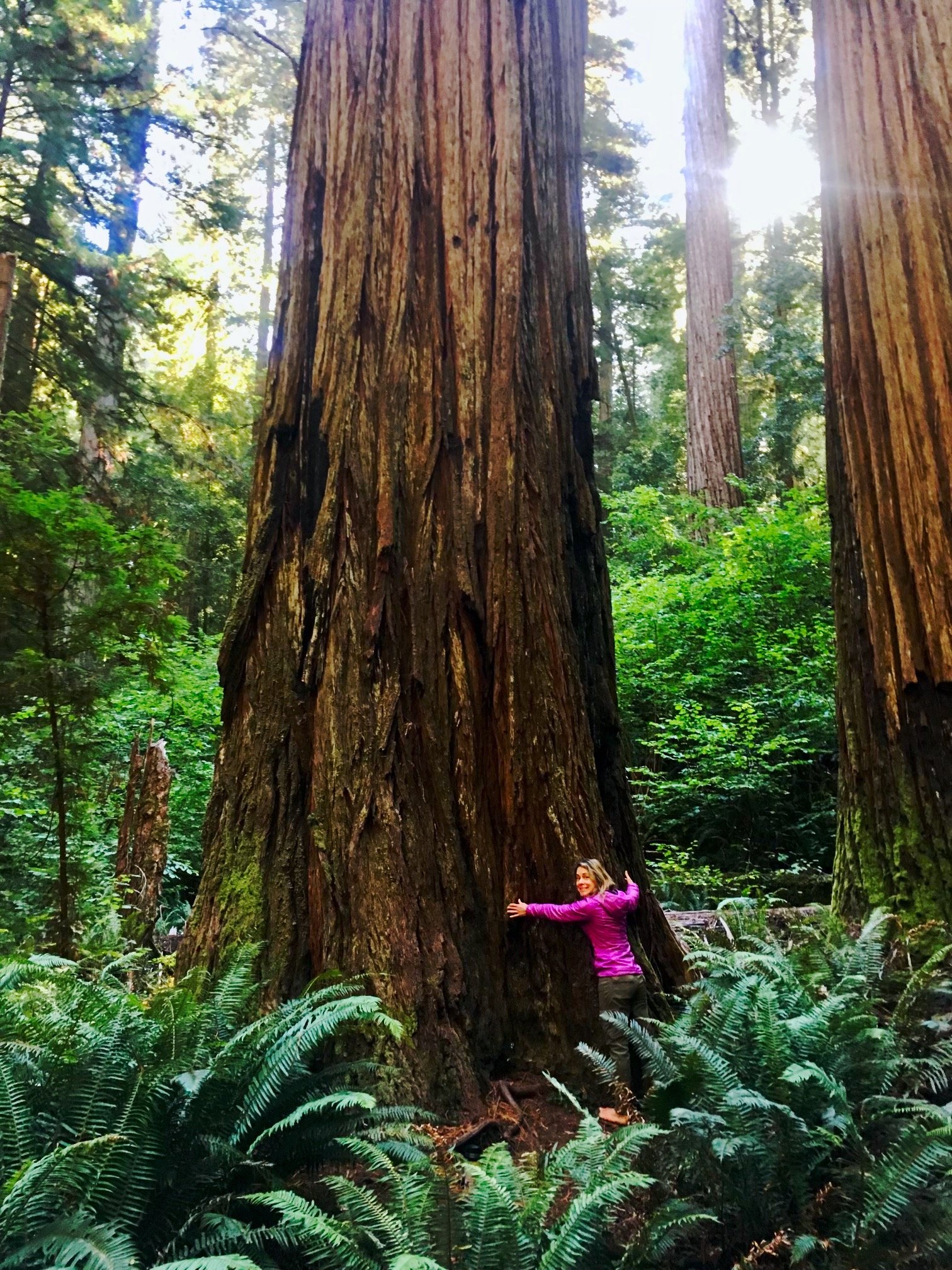The Forgotten Coast: A Rock Climbing Road Trip Guide to Northern California
Sierra Farquhar on Wave to Ya Ma on Wedding Rock at Sue-Meg State Park, photo by Evan Wisheropp
Northern California is known for giant redwoods, dank buds, and Bigfoot, but is also home to unique rock climbing. From blue-gold limestone walls, to beach bouldering, to overhanging jug hauls above the ocean waves, there is something for everyone in this quiet part of California. The 5-7 hour drive from population centers may be less-than-convenient, but you will be rewarded with a refreshing lack of crowds and great rock.
The Trinidad Area
Starting from the Bay Area — San Francisco and surrounding cities — you would head north on State Highway 101. Alternatively, if you are coming from Bend, OR, go south on The Redwood Highway. Either way this region is off the normal climbing circuit. My boyfriend and I embarked on our climbing trip from Colorado, and made our first stop at the Sierra Nevada Brewing Company in Chico. There we drank America’s most popular pale ale and perused the newest climbing guidebook to the Northern California area, Evan Wisheropps’s Redwood Burl. Short on time, with just over a week to climb, we thoughtfully devised a hit list. Evan’s photo-studded guidebook lists over 1,300 routes, with crags conveniently organized by the main points of highway access, allowing for easy planning. The guide also recommends crags based on the type of adventure you are seeking — trad climbing, multi-pitch, best hard and easy sport climbing, and my favorite category, “best climbing over waves”!
With Evan’s easily navigated guide, our challenge of narrowing so much brilliant climbing into our short trip was done before we finished our beers. Because it was late September, slightly out-of-season, we decided to risk hitting the most popular crags, hoping to miss the summer crowds. From Chico, we headed for Highway 299, to check out the Trinity Arêtes first. Then we’d head west to the college town of Arcata and the coastal crags.
Our route through Northern California
The Trinity Arêtes
Kyle Sherby on Paisano Direct (5.12d), photo by Cobi Krumholz
Trinity Arêtes is likely the best-known crag in northwestern California. To get there from Chico, we drove north on I-5 to Redding, then turned west onto Highway 299. This route runs all the way to Coastal Highway 101, mostly following the Trinity River, and there is even more climbing along the way. As we turned off the highway near Burnt Ranch, we wound our way through the emerald green forest and were soon ogling the 200-foot walls that towered above us. Some of the most beautiful blue and gray limestone we had ever seen in the US was peeking out from behind the veil of the “Redwood Curtain.”
The grueling two-minute approach to the base revealed more details about the climbing. The rock varies from crimpy vertical walls, to radically overhanging caves, and of course, to its famed feature, giant arêtes. The routes range from 5.7 to 5.14, with plenty of variety. Both my boyfriend and I were impressed with the classic sport cave at Paisano Buttress, with routes from 5.12+ to 5.14, including Paisano Direct (5.12d), purportedly one of the best 5.12+ sport routes in California. For another unforgettable classic 5.12 endurofest, check out Whiplash (5.12b) at the Lower Shooting Gallery. If you’re looking for more moderate routes, Bambi Slayer and Gold Rush are both 5.11 ultra classics, found in the gently overhanging Upper Shooting Gallery sector.
Impressive as they were, the Arêtes are wooded and north facing, and in late September it was chilly. In between climbs, we sought out small pockets of sun to warm our frigid fingers. If you are looking to visit in the fall, check out the Sunny Sanctuary — this would have been a great option had we known how cold we would be at the Arêtes. Other options include Castle Rock, The Roost, and the So-So Grotto. On nearby Horse Mountain, you will find Land of the Lost, Cold Springs, Chezem, and Five and Dime. Or for a high-alpine adventure, the Trinity Alps are also accessed off Highway 299.
Once done for the day, we took advantage of the off season and camped near the crag’s parking. If this hadn’t been an option, there were several other primitive campsites to choose from nearby, and we’d passed more great bivy spots earlier on the road. Just watch out for Bigfoot — this is a seriously dense forest! If you do have any encounters and need your cell phone, the nearest reception is at Willow Creek, the summit, or up at the Sanctuary.
Rest Day: Best Things to Do in Arcata
The groovy town of Arcata is the base area for the local climbing scene, specifically because Humboldt State College is there. Arcata has great restaurants, breweries, and grocery and outdoor sports stores. Plus there is an endless list of rest-day activities (hello, surfing, hiking, and giant redwoods!), and you can’t beat the many coastal campgrounds and lodging options as well.
In town, we stocked up on groceries at Wildberries Marketplace, which offers great food, delicious coffee, and a hip vibe. There, we bumped into some local climbers and learned that Wildberries is a popular meeting place to carpool out to the beach crags. Afterwards, we dropped by The Adventure’s Edge, a great outdoor-sports store, to browse and chit chat with the employees about where we should eat. They suggested Arcata Pizza and Deli, where the owner sometimes cooks up fresh fish that he catches himself. Some other recommendations were The Salt Fish House, Oak Deli and Brewery, Bencharong Thai House, and Renata’s Creperie.
After pizza we headed to the Big Lagoon County Park to camp which is a first-come, first-served site. If you don’t mind booking your campsite in advance, there are plenty of beautiful campgrounds along the coast, just reserve early as campgrounds near Arcata fill up fast. In our experience, even in late September this area attracts many tourists because of the giant redwoods. Note that many campgrounds close in winter and there is no free primitive camping along the coast. Other campground options near the coastal crags are Clam Beach, Sue-Meg State Park, Gold Bluffs Beach, Flint Ridge, and Del Norte Coast Redwoods State Park.
Photo of Arcata by Evan Wisheropp
Climbing Off U.S. 101 North
Promontory
Matthew Crockett on Great White 5.12b, opposite, photo by Evan Wisheropp
The most northern crag we visited, Promontory, is about an hour north of Arcata and 15 minutes south from Crescent City. It is the premiere North Coast crag in California. Here you will find beautiful, sculpted sandstone, with overhanging jug hauls reminiscent of the Red River Gorge, and routes ranging from 5.7 to 514. Promontory is in season year-round, with rain and fog being the only limiting factor. Temperatures along the coast are generally mild all year, as opposed to inland where summer can get stiflingly hot. At Promontory, routes generally get afternoon sun, so spring and fall is your best bet for good, dry conditions. Winter can be good too as long as it hasn’t rained too much, since some of the routes can seep. For us, the warm autumn morning gave us splitter conditions to climb in the shade, and plenty of sunshine and rock to gecko out if we got cold.
As we approached Promontory from the Wilson Creek Beach parking lot, we had no idea just how stunning and unique this place would be. We gazed in awe at the only crack on the wall, Ethan Pringle’s notorious 5.14c route, Black Beard’s Tears, considered among the hardest trad routes in the world in 2016 when he made the FFA. The Main Wall is laced with steep jugfests and proud vertical routes with crimpy holds. While the entire crag was re-bolted in 2015, bringing increased popularity and traffic and cleaning up the once-sandy routes, we were pleased to be the only climbers aside from one other couple.
After warming up on some sandy but really fun 5.10 pocket climbing, we did Lost at Sea (11d), a crag classic. If you are a 5.12 climber, do the steep Great White (12b), an ultra-classic that will have you pumped to the gills unless you’re creative enough to find the hidden rests. On the Abyss and the Exploding Energy Boulders — huge seaside rocks next to the main wall — must try classics including Plague of the Flies (5.9), Lord of the Flies (11a), and Riptide (12a). Keep in mind, there will be plenty of ocean spray.
Though we could have climbed much longer at Promontory, we decided to check out the adjacent Footsteps the next day. We camped at the sublime Del Norte Coast Redwoods State Park, only 7 miles north of Promontory. This campground closes September 30, so we were lucky to have scored a site there and be so close to such amazing climbing.
Main Wall at Promontory, photo by Evan Wisheropp
Footsteps
In Evan’s guidebook, Redwood Burl, we had read that Footsteps has some high-quality classic routes, a dicey approach, and the views are among the best on the North Coast. We walked north at low tide from Promontory (you can also approach from the road, but Evan’s beta warned of poison oak) to Footsteps. The rocky 40-minute approach was indeed tough, especially on our little mutt dog, and we were even blocked by angry sea lions at one point… but that didn’t stop us. We tiptoed around the sea lions with the utmost respect, and found ourselves to be the only humans, at the crag.
After our adventurous approach, we were rewarded with a magical crag. We stuck to the clean and newly bolted South Rock, climbing pocketed, Promontory-like classics such as Porifera (10d) and Osteoporosis (11b). Swallow the Sea (12b), Sea Salt (12a), and Sprinkling Pockets (12b) rounded out the steep pocket-pulling at the wall. At this point we were pretty spent and quite honestly, being from a landlocked state, the crashing waves, occasionally crumbly rock, and scary sea lions had us a bit gripped. We were ready for a rest day.
Night climbing, photo by Evan Wisheropp
Rest Day: National and State Parks on the Northern California Coast
Roadtripping through the California Redwoods
No trip to the Redwood Coast is complete until you visit the redwoods! There is a complex of four national and state parks where you can see these giants, and you can’t go wrong. We decided to check out the Boy Scout Grove in Jedediah Smith State Park, which was simply amazing. Being dwarfed by these massive trees gave us such a magical feeling that cannot be felt anywhere else in the world. We followed tree-gaping with an early dinner at the Seaside Restaurant in Crescent City and, to end this stellar rest day, we took a walk in the warm sands of Pebble Beach to watch the sun set.
For a longer trip, there are endless activities for any climber’s rest days. There is hiking in Fern Canyon, kayaking, seal watching, surfing, mountain biking, beach-going, and even deep-water soloing. Take your pick — and don’t forget to rest!
“Being dwarfed by these massive trees gave us such a magical feeling that cannot be felt anywhere else in the world.”
Trinidad Area Rock Climbing
Kyle Fisher on Assembly Line on Karen Rock, photo by Evan Wisheropp
Being from Colorado, climbing right on a Pacific Ocean beach was our (mostly my) primary goal for this trip, so we spent some time around Trinidad, the next town north of Arcata. As at Promontory, locals climb year-round here, finding mild winter days a nice respite from the inland summer heat. Plus, it’s all within a 25-minute drive north of Arcata on Highway 1. Trinidad itself is an authentic little beach town, located between Arcata and Sue-Meg State Park, with some great restaurants and wine-tasting venues. We dined at the Moonstone Beach Bar and Grill, which had spectacular ocean views and amazing food.
The O.G. local climber’s crag is Moonstone Beach. Located just 15 minutes north of Arcata, it’s the closest hang for an after-work bouldering or top-roping sesh. Expect a vibrant scene with kids surfing, family picnics, and dogs playing. We even saw a little pet pig there — my mutt had a moment when she saw this strange looking animal, and bolted down the beach and hid behind some boulders. We calmed her down, leashed her up, and headed to Karen Rock which has several really fun top rope climbs, with Karen Crack (5.8), Urchin (10c), Assembly Line (11a), and Nightmare (12a), being the best.
We didn’t have time to visit, but for great bouldering, Houda Point is only a few-minutes drive north of Moonstone Beach. There are dozens of great and varied lines here, with big jugs, desperate crimps, highballs, and overhangs. The height of the boulders fluctuas due to the changing sand levels, keeping even the locals guessing on meters. Check out the V1 Jugtacular and Houda Crack (V5).
Sue-Meg State Park
We then headed to another of the Redwood Coast’s climbing jewels, Sue-Meg State Park, formerly known as Patrick’s Point. Cragging in this park goes back to the 1970s, so we wanted to check out some of the classic routes. There is a surprising amount of great rock climbing in this spot, with varied, well-featured, and enjoyable routes, which are almost always done on toprope. Bolting is not currently permitted in the park, and old fixed hardware quickly becomes unreliable on the salty coast, but there is a good selection of trad routes in Sue-Meg State Park for the more adventurous, as well as a little sport climbing.
William Murphy lowering off Doozy, photo by Evan Wisheropp
We followed tradition and first opted for top roping, climbing Wave to Ya Ma (5.8), Principle of Perplexity (11a), and Pandiculation (12a). We did not make it to Mussel Rock, but there were two harder toprope routes on our must-do-next-time list, A Fine Line (12b) and Doozy (13a). In all, Sue-Meg has four main sectors, Ceremonial Rock, Wedding Rock, Pacific Ocean Wall, and Mussel Rock. It is a many-day endeavor just to get acquainted with all the great routes here. Be sure to check the guidebook for its excellent approach and anchor beta, as both can be eroded and/or difficult to find. Before rounding out the day at Wedding Wall, we hit the Pacific Ocean Wall with its excellent sport climbs, Whale Nation (10d) and Superstitious (12b).
Phew! There is so much great climbing in this park, you could stay busy for years. If you are lucky enough to get an open site at the park campground (reservations required May-September), you can sleep to the sound of waves crashing, wake up with the sun filtering through the fog-enshrouded spruce trees, and spend rest days exploring this small park without ever leaving. There is great hiking along the Sue-Meg park perimeter, through lush forests where you can hunt for agates, explore tide pools, and even watch for seals and migrating whales. There is also surfing, boating, biking, and just plain beach-going.
Cari (author) tree hugging a California Redwood
Truthfully, we should have set aside much more time for this trip, and chalked it up as a reconnaissance mission. We will definitely be back to check out some of the crags we never even got close to visiting. Had there been more time, cooler temps, and more clouds, we would have been stoked to check out Marble Caves, a treasure trove of over 120 routes on beautiful blue-gold limestone. With most routes in the 5.10-5.12 range, on vertical and gently overhanging rock, tons of free primitive camping, and a stunning and secluded landscape, it sounds perfect.
This NorCal climbing trip was one of our most enjoyable trips ever. Not only because of the quantity and quality of the routes and crags, but because of the lack of crowds, concentrated layout of the crags, and truly some of the most spectacular scenery in the country. The laid-back towns had great restaurants, the coastal camping was fun, and the juggy sandstone climbing over crashing waves had us immediately planning our next road trip to this region. Just thinking about the Redwood groves, the seals playing, and taking dog walks along the serene beaches brings me back to this special experience.
Evan Wisheropp’s, Redwood Burl: A Climber’s Guide to Northwest California
Redwood Burl is a compact yet comprehensive guide to the extensive climbing in Northwest California. The college town of Arcata is the center of a universe of incredible but little-known cragging and bouldering. Sea cliffs, sea lions, river-polished boulders, towering redwoods, hidden limestone caves, and enough climbing to keep you busy for a lifetime. It’s a paradise. For years, road-tripping climbers in the know have visited the limestone of the Trinity Arêtes and the overhanging seaside pockets of Promontory, declaring them some of the best sport crags in CA. This book fully documents these gems, and introduces dozens of other excellent cliffs that have hidden under the radar … until now!
There’s a lot packed into this guidebook. You’ll find maps to keep you oriented, icons depicting sun and rain aspects, hiking approach times, geology and ecology info, gorgeous color photography, and enough beta on bouldering, sport, and trad climbing to keep you busy whether you’re just visiting the area or a seasoned local.














